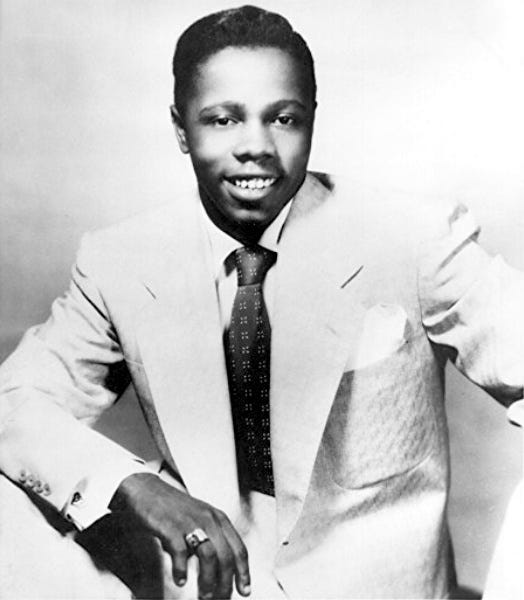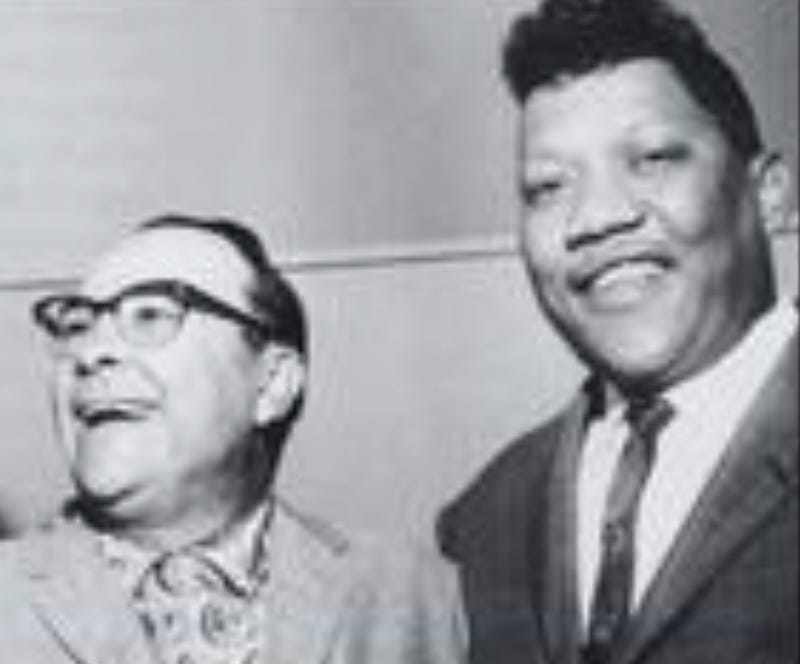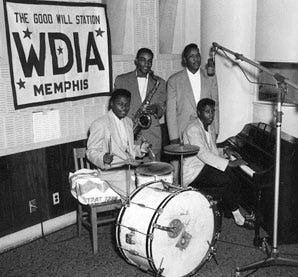May This Fire Forever Burn
Steve Bergsman goes deep into the mysterious deaths of three legends
The life of a professional musician can be a hard one. Mixed with a little success, it can be down-right dangerous, with the quilt of popular music history being patched with an unfair amount of tragedy. In his recent book Earth Angels: The Short Lives and Controversial Deaths of Three R&B Pioneers, music writer Steve Bergsman digs deep into three such tragedies, with his subjects being true music legends: Jesse Belvin, Guitar Slim, and Johnny Ace…all who met untimely deaths shrouded in mystery.
With the book’s title Earth Angel taken from the most famous song Belvin ever co-wrote (one of the biggest defining hits of the era), it hints at the prophetic ends of the popular, hard-working rhythm and blues players at the time, with dark forces constantly pulling down on the mortal frame while the artists simultaneously release beauty unto the world. Guitar Slim’s death reads more cut and dry than the others, with the Specialty artist who hit big with The Things That I Used To Do succumbing to a lethal mixture of drink, touring and maybe a little heartache mixed in. But was Belvin’s fatal head-on car crash race related? Was Johnny Ace’s Russian Roulette blast on Christmas Day, 1954 not as much of an accident as it seemed?
Of the three, Johnny Ace’s demise is probably the one that is still most discussed inpopular culture. Maybe it was do the his legendary status emboldened by the countless tribute songs written about him shortly after his passing: Varetta Dillard’s Johnny Has Gone (sappy), Frankie Ervin's Johnny Ace's Last Letter (love), Linda Hayes' Why, Johnny, Why? (SAPPY), The Rovers' Salute To Johnny Ace, and The Five Wings’ double a-side Johnny Has Gone/Johnny's Still Singing (both sappy). They have continued to come the decades: Paul Simon recorded The Late Great Johnny Ace, Dave Alvin released Johnny Ace Is Dead (killer), The Squirrel Nut Zippers did their tribute to Johnny and his sound with A Johnny Ace Christmas and I even released a song about him on Birdman Records with Captain Memphis (Jim Dickinson) and Sonic Boom (Spacemen 3) called The Lonesome Death Of Johnny Ace. There was something about his star that shined, the way he died, the day he died, the legend behind his name and fame, that has demanded a telling and retelling over and over, continuing up til present day.
Ace was “discovered” by Ike Turner in 1951 when Turner was working for Modern Records and Ace was playing around Memphis with other “Beale Streeters” including B B King and Bobby Bland. Ace signed to Duke the following year (and Bland the year after), finding instant success with his first single, My Song leading to a string of more hits like Never Let Me Go (such a classic) and Saving My Love For You. Ace was a heartthrob who wrote love ballads that stirred a nation. By 1954 he was Cash Box Magazine’s Most Programmed Artist of the year. Yes, the year that ended with his death.
Steve Bergsman is no stranger to Ace’s story. In 2012 he published the stand-alone book, The Death of Johnny Ace. The section of Earth Angels about Ace is my favorite of the book, with Bergsman focusing not only on Ace, but also on Don Robey, the head honcho of Ace’s label Duke Records. Bergsman introduces Robey earlier, during his section on Guitar Slim, and goes on to describe him as a dark figure who treats his artists badly, acting more like a mob boss than a loving record label owner. The question at hand: was Robey behind the death of Johnny Ace, which occurred as Ace’s record sales were waning? What really went down on that Christmas day?
The following is an excerpt from Earth Angels: The Short Lives and Controversial Deaths of Three R&B Pioneers by Steve Bergsman reprinted with permission from Texas A&M University Press (THANK YOU!). The passage begins at the near-end, on December 25, 1954. Ace is scheduled to play a set following Big Mama Thornton, who he often toured with…
~~~~~
Johnny Ace had already sung a duet with Big Mama Thornton, and he was the closing act, so he ought to have been preparing to go back onstage. Was he so sure of his invincibility that he would play Russian roulette? It’s doubtful.
The more likely scenario is that Johnny Ace did not know there was a bullet in the gun. There are many stories about Johnny Ace shooting his gun at signs and inanimate objects. Also, stories abound about Johnny Ace traveling with his pistol and mock-firing with an empty cylinder. And if he didn’t know there was a bullet in the cylinder, how did it get there? That’s the mystery.
A little over a month later, a different take on the facts appeared. Originally a wire service story out of Houston but appearing in many African American newspapers, such as the Pittsburgh Courier on February 5, 1955, was an article about one of the principals in the Johnny Ace drama, Olivia Gibbs. Now calling herself Johnny Ace’s fiancée, although he never divorced, she said that of the morning of the shooting Johnny had been drinking and playing with a gun. She had made him stop. Then, she claimed, he had displayed a diamond ring she had given him. But Gibbs was a waitress at one of Robey’s Houston clubs and couldn’t afford to be giving away diamond rings.
Gibbs she told the journalist:
He went around snapping it [his pistol] at people. . . . Willie Mae Thornton, a blues singer, said she prevailed upon Ace to give her the gun and he had snapped it at herself, Miss Gibbs and Joe Hammond, another singer. Miss Thornton said she turned the chamber and a bullet fell out. Johnny Ace continued to snap the gun at others in the dressing room. Finally, Joe Hammond said, “You snapped it at everyone else, try it on yourself.” “Now watch me,” said Johnny, “I’ll show you it won’t shoot.” With his arm around Olivia Gibbs, Johnny placed the gun to his temple. Crack! went the gun. Ace fell to the floor mortally wounded.
Gibbs also told the reporter that she had loved Ace and he had loved her and that he had been separated from his wife since 1952. She hoped for a divorce by June 1955. “Then we would have married,” she said. “He called me every night when he was on the road, as if he wanted to hear me for inspiration.”
None of the stories about the night Johnny Ace killed himself mention Robey, although by some accounts he saw Ace that day, and according to one source they quarreled.
Lauterbach interviewed a man named Sax Kari, who worked for Robey in the 1950s, and his story was that even if Robey didn’t pull the trigger, it happened under his direction. In Sax Kari’s telling, Robey coerced Big Mama Thornton into slipping a bullet into Johnny’s gun. In exchange, he would continue his work making her a star.
Thornton would have only needed to fabricate the story she told police about Ace telling her to put the bullet back in the gun, because if Johnny knew about the bullet, he would have been responsible for its consequences, his own death or someone else’s. That’s a key point because if he did not know about the bullet, then he was being set up. Olivia Gibbs, wrote Lauterbach, told the police she didn’t know thing about the gun being loaded.
Lauterbach concluded, “For Robey, Russian roulette was a beneficial ruling from the county authorities, implying that Johnny knew there was a bullet in the gun when he pulled the trigger. Closing the case immediately cancelled any further investigation.” A county coroner’s inquest ruled that Ace’s death was self-inflicted.
Roy Head once referred to Robey as black mafia. While not truly mafia, Robey dealt with New Orleans quite a bit in the music business, and the Crescent City was a mafia town. Robey knew how the mafia worked. If the mafia did something for you, it expected something in return, and that’s how Robey operated. If he did something for you, say awarded you a Cadillac and thousand-dollar check, then you would accept him taking 50 percent of songwriting credits, which could end up as a hundred-thousand-dollar bonus to him. He took care of Big Mama in her early days at Peacock, and he probably gave money to Olivia Gibbs as well. A couple of years later it was time to collect on that payment. Someone needed to slip the bullet into Johnny Ace’s gun.
While Robey setting up Johnny Ace for a death through Big Mama’s or Olivia Gibbs’s complicity falls into realm of conspiracy theory, a lot of people who knew Robey thought him quite capable of murder.
Years later, when Roy Head was under Robey management, he said, “Everyone who worked at Duke-Peacock still thought Robey had him killed, although by that time there was no way to prove it.”
Lavelle White was in Houston but not at the show when Johnny Ace died. “It was the saddest thing I ever heard. I don’t think he shot himself. It was someone evil who killed him.”
Even Roger Wood, who thought highly of Don Robey and what he did for the Houston music scene, admitted there were a lot of people who believed Robey had planted the bullet.
One thing is fairly certain: Robey showed no grief for Johnny Ace’s death. What he did exhibit was a cold efficiency for promotion in the wake of the death. This only fueled the second part of the Robey conspiracy theory. Johnny Ace’s sales were slipping, and he put in place a scheme for the Hank Williams effect. As Wood observed, some folks suggest Robey caused the death of Johnny Ace because of what he had seen when the twenty-nine-year-old country singer Hank Williams died on January 1, 1953. About six months prior, Williams recorded a song called “I’ll Never Get Out of This World Alive.” Soon after Williams’s death it went to number one on Billboard’s country chart.
Like commanding troops before a major battle, Robey swung into action, arranging publicity, orchestrating a funeral worthy of a potentate, and getting Ace’s last record, “Pledging My Love” played and available to a waiting public.
The funeral on January 2, 1955, was set held at the beautiful and historic Clayborn Temple, then an AME church, within walking distance from Beale Street. Pallbearers, including Beale Streeters of yore – B. B. King, Rosco Gordon, Little Junior Parker, toasted their comrade at the Mitchell Hotel and walked through the throngs to the church. A Memphis photographer named Ernest Withers documented it all, and Robey made sure photos went out to the African American press, including the Associated Negro Press Wire. An estimated five thousand people attended the funeral, although crowd size reports may have been boosted by Robey’s grander estimation. Johnny Ace was buried at Memphis’s New Park Cemetery.
“Pledging My Love” took off like a rocket to the stars.







